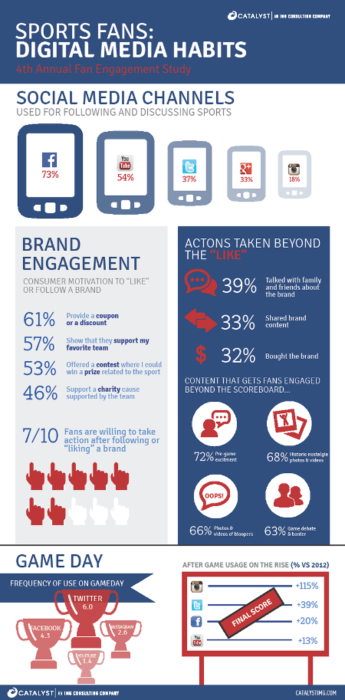Sports fans are emotional, vocal, and huge consumers of all types of media. Brands that can directly connect with them have an opportunity to create massive digital engagement and crucially, get them to act on calls to action.
The results from the Fan Engagement Study conducted by Catalyst, an IMG consulting firm showed almost 70 percent of sports fans
who “like” or follow brands on social media are willing to take additional
action during sports events, including purchasing, commenting or sharing brand content.
“Content strategy is a major component for any brand, and this study reinforces that sports fans frequently consume and engage with social content that takes them well beyond the box score,“ said Bret Werner, senior vice president and managing director at Catalyst. “Avid sports fans are more likely to interact and identify with brands that act like fans.”
The study, conducted annually since 2010, collected information from over 2,100 avid sports fans aged 16 – 64, measuring the digital media
attitudes and usage habits of NFL, NBA, MLB, college football and basketball. This was the first year soccer fans were included, with international data gathered from fans in Brazil and the UK.
Here are some of the key findings from the study, and an infographic:
While Facebook remains the
most widely used channel, fans are increasingly using Google+ and YouTube to
disseminate and acquire sports information
Google+ (+94%) and YouTube (+35%) witnessed the largest
year-over-year growth
Fans frequently engage with
content that advances story lines or provides a point of view
Pre-game excitement (72%), historic video (68%), bloopers
(66%), Q&A with coaches and players (66%) and game debate/banter (63%) are
among the most popular
Game day social
network interaction is on the rise
Fans engage on social channels before, during and
after sporting events at a higher rate than ever before. In some cases,
engagement is more than 30% higher than compared to 2012.








